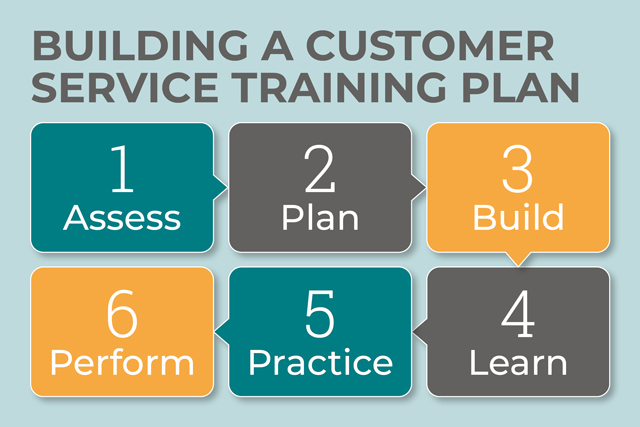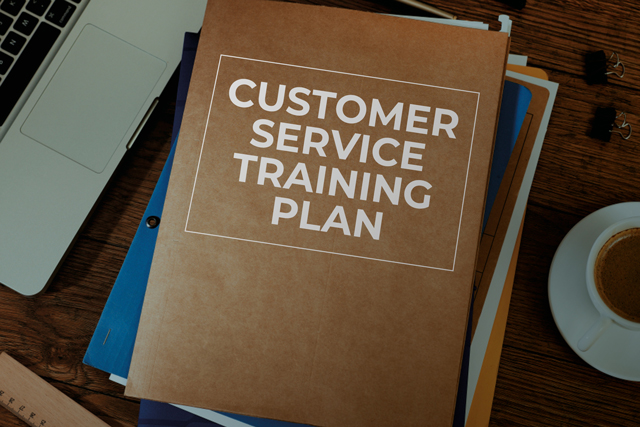
How many times do you walk into a brick-and-mortar store and have a negative experience with someone who works there? Perhaps they are rude, or not knowledgeable, or they simply do not take the time to offer you great service.
It’s enough to make you never want to walk into that store again.
Now, imagine what happens when that interaction happens online. Think of the frustration that comes without the connection of a face-to-face interaction. Worse, you might never know that online customer has had a bad experience. Poor customer service will cost you.
Fortunately, it can be corrected with the right training.
There was a time when companies would hand new employees a thick binder full of policies and “how to treat a customer” checklists, offer up a written test of the information, and then release them to deal with people directly.
Which left reps woefully under-trained, inexperienced, and unprepared for customer interaction.
Today, those thick binders have become online courses. Managers think that these are more effective because they offer video examples and interactive quizzes to drive home the information more clearly.
But are they more effective?
As it turns out… no. This is just a different version of the same training that failed past employees.
If you are the manager or head decision-maker of a company, you need to know how to equip your employees with the tools and training they need to better handle customer interactions—preserving your business and increasing your customer base over time.
What’s the secret? Look no further than the gold standard of customer service…
- How Zappos Set the Bar for Customer Service Training
- Why Customer Service Training Must Be Prioritized
- You Need a Plan
- The Foundations of a Good Customer Service Training Plan
- The 6 Steps of Building a Customer Service Training Plan
- Hiring the Right People
- Your Company Needs a Customer Service Training Plan
How Zappos Set the Bar for Customer Service Training
For years now, Zappos has been a leader in both e-business and customer service.
Six years in a row, Zappos has been one of the Fortune 100 Best Companies To Work For. It is worth over a billion dollars—largely thanks to their fantastic customer service.
The customer service department of Zappos is well-known for the decision-making power that their reps hold. They are able to make independent decisions on discounts and conflict resolution that preserves their customer experience and keeps sales high.
Add lightning-fast shipping at no additional cost, and free return shipping for any reason, and it feels like Zappos gives away the farm.
But that’s not why they are successful. They are successful because their reps go through extensive customer service training.
Think of the average company customer service training. How long does it last? A few days? Maybe a week?
At Zappos, every employee is required to complete a four-week intensive training program all about customer service.
They put their money where their mouth is, and that’s why they lead the industry in customer service.

Why Customer Service Training Must Be Prioritized
If you aren’t training your employees properly, you can’t expect good customer service.
And when that happens, there are lots of fallout consequences, including:
- High employee turnover due to employees who do not value their skill sets.
- More time and expense in training new employees to replace them
- Less focus on each employee’s development, leading to a decrease in skills
- Increased time having to deal with unhappy customers
- Loss of sales, customers, and market share
In short, your business needs to be built on the backbone of strong customer service training if you want any hope of competing in your industry.
But that doesn’t mean you simply need to talk to them about treating customers well. You aren’t going to correct this in a company-wide meeting or two, or by sending a memo around.
You Need a Plan
Well-trained employees improve the customer experience.
When your customer is satisfied, they will buy more, be more loyal, and potentially bring in more customers through referrals.
The return on investment grows when you consider how properly-trained employees drive down the costs associated with customer support.
Employees can handle a higher workload of customer cases. There is less turnover as they will feel valued. More sales will be saved with empowered agents who can handle customers more effectively.
This is all well and good, but what does it mean to create a plan? What makes a great customer service training plan, and how do you implement it effectively?
The Foundations of a Good Customer Service Training Plan
It’s difficult to create a “one-size-fits-all” training plan that works.
The truth is, every employee that comes to your job brings with him or her a lifetime of existing knowledge, experience, and opinions.
Handing them a binder of company policies doesn’t do much for them.
Instead, you have to create a plan that hits a few key points—which will increase engagement and effectiveness among your employees:
- Self-directed. There should be a component of the program that allows employees to work through it themselves. This increases autonomy and engagement.
- Goal-oriented. Each piece of the training should be focused on accomplishing a specific goal.
- Relevant. No matter what, your training needs to be relevant to each person’s job. If your employee will not be dealing with customers directly, leave that part out.
- Task-oriented. Each employee needs to have a clear list of tasks that they need to complete in each lesson or module.
- “What’s in it for them?” Just like marketing your business, your training program needs to show employees why they should be focusing so much on employee satisfaction. Demonstrate why it makes their jobs better.
Employees are just like your customers: they want to feel respected and valued. Design your training program to assist them, not talk down to them.
As far as format goes, one effective rule is the “70-20-10” philosophy: 70% experience (activity-driven), 20% social (interaction), and 10% formal training (classroom/lecture/training modules).
More employees learn from experience, so make it the primary focus.

The 6 Steps of Building a Customer Service Training Plan
If you want your training plan to be as effective as possible, you need to move through a specific, organized process for creating the plan itself.
Here are six steps you can follow to make that happen efficiently, while covering all the bases:
1. Assess
Before building a plan, you need to know what your goals are. Talk to your team members and listen to their feedback on what you need. Review the data and consider your market. What is your competition doing? This step is all about identifying the challenges and needs of your team. Don’t leave this step until you have very clear objectives about where your team is currently at.
2. Plan
Yes, “Plan” is one of the steps of creating a plan. This is all about goals. What are the objectives and outcomes you want to achieve with your plan? What does an employee know that they didn’t before, and how can that improve their ability to do the job? What milestones can you create throughout the program for employees to achieve?
3. Build
Now, we get into creating the training content. Focus on clarity and brevity. Don’t build a lot of fluff into it, or you will lose engagement. Work with your existing employees to tailor it to their needs and ways of learning. Try to make the learning as bite-sized as possible to account for short attention spans, and include multimedia whenever possible. Don’t create in a vacuum, either—gather feedback from employees as you go along. And focus on getting to 80% complete. There will be missing components and things you need to go back and review. Don’t aim for perfection. Perfection will come in time.
4. Learn
Now is the time to gather feedback from your employees. Push them through the training. Create assignments that they need to accomplish. Make it a priority, and gather feedback from them after they complete each training module. Make sure leaders and managers also go through the training and discuss it with the employees—create that engagement from the top down to drive home its importance.
5. Practice
Keep it ongoing. This is a never-ending phase. You always want to make customer service training an ongoing process that employees engage with regularly to keep it fresh. This also gives you the chance to gather feedback regularly so you can continue to assess and adjust the plan.
6. Perform
Now that your employees are trained, you need to measure the key performance indicators (KPIs) that determine whether or not the program was a success. Trust the process and the people you’ve hired, and make sure you are basing your decisions on actual performance of your company.
You now have a solid training plan in place and are routinely gathering feedback about it, tweaking it as you go.
You’re done, right? No.
There is one more piece of high-quality customer service you need to incorporate if you are going to be successful at it…
Hiring the Right People
The best plan in the world does you no good if you are staffing your team with those who are bad at providing customer service.
The fact is, some people just don’t have the skill set necessary to handle customer service. They have other strengths.
To avoid matching up your new plan with the wrong employees, look for these signs of a great employee:
- Excellent communication skills
- Strong people skills
- Experience in customer service
- Thorough understanding of the company’s products and/or services
These are the candidates that will respond well to customer service training.
Why? Because they are already working with many of the soft skills necessary to be successful.
In other words, you can train someone on processes. But it’s harder to train them on people skills.
You can enhance their soft skills with a blend of storytelling, shadowing, and roleplaying practice. These are effective ways of helping someone develop their communication skills.
But don’t put yourself behind the 8-ball out of the gate. Hire the right people at the start, and customer service training can be a lot more effective—and easier.

Your Company Needs a Customer Service Training Plan
It’s time to prioritize training your customer service team.
When you bring high-level customer service to your company, you will see immediate benefits.
But don’t leave it up to chance. By creating a detailed process tailored to your team and your employees, you can build a customer service training plan that will empower your employees and grow your business.
Customer service is a foundation of how your business operates. Treat it that way.
Want to learn more about how to transform your customer service center into a revenue generator?
Join our live interview with GQ Fu, Driving Revenue with Customer Service, to learn all the secrets behind turning customer service into a profit engine.
We'll cover how software like ProWritingAid can boost your team's speed and quality, no matter how many tickets they have to go through. Then, we'll discuss the right way to design macros and scripts so your team can personalize every customer interaction. And finally, GQ will share the same frameworks he uses at LTVplus to transform outsourced agents into the mouthpiece of a brand in the least amount of time.


